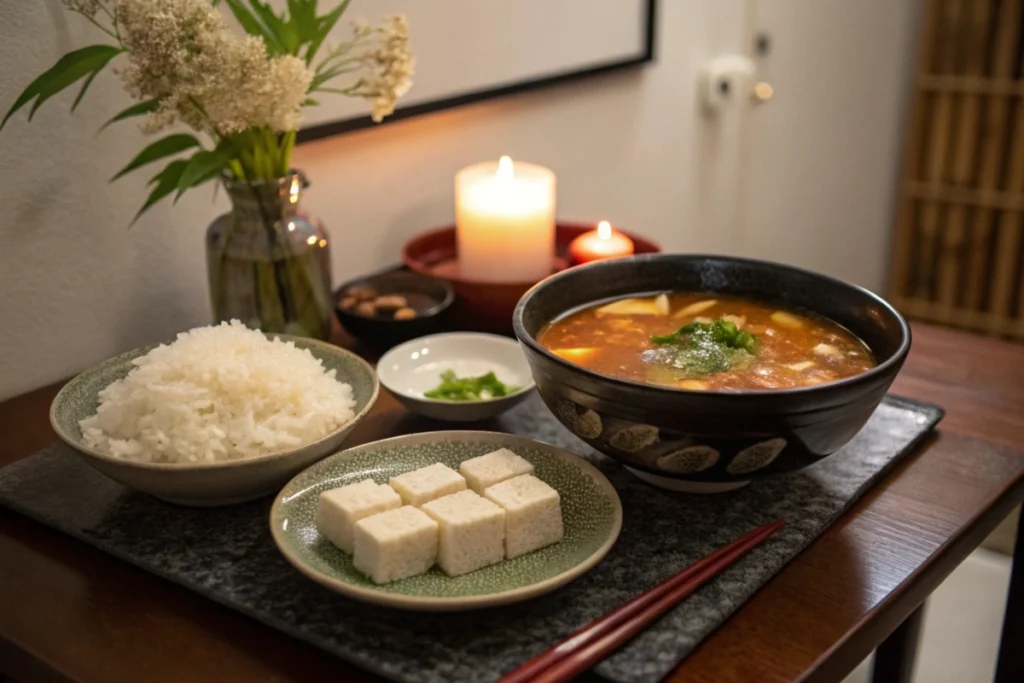When people think of hot white Japanese food, they often imagine steamy bowls of comforting goodness and silky textures that delight the palate. From pillowy mochi in a hot soup to soft, sticky mochigome rice in onigiri, Japan’s culinary scene features an array of white, steaming delicacies. Yet, what truly defines these “hot white” dishes is not just their color but their warmth, texture, and the sense of comfort they bring. In this article, we’ll uncover various typical dishes in Japan that fall under this category, as well as their cultural significance, history, and practical tips for cooking them at home.
For added inspiration, consider our discover-japanese-recipes page to explore more on Japanese cuisine and expand your repertoire beyond these hearty, warm-white meals.
Introduction
Hot white Japanese food conjures images of soothing, cloud-like meals that nourish both body and spirit. These dishes are often staples of home cooking, served to bring comfort during cold winters or as satisfying everyday fare. But what exactly qualifies as hot white Japanese food? Generally, it refers to steamed, boiled, or gently simmered dishes featuring white ingredients—rice, tofu, fishcake, noodles, or mochi—topped off with a warming preparation that highlights their natural color and texture.
In many parts of Japan, white foods symbolize purity, simplicity, and minimalism, reflecting core values in Japanese aesthetics. Whether it’s a fluffy bowl of plain rice (gohan) or a creamy miso-based stew, these dishes embody the essence of traditional food in Japan, showcasing clean flavors and a gentle approach to seasoning.
Curious about how to make these dishes at home? Throughout this article, we’ll detail key ingredients, cooking tips, and the cultural background that shaped each item’s place in Japan’s culinary scene. If you’re looking for a broad exploration, start by visiting our best-japanese-foods to see how these hot, white favorites fit into the wider landscape of Japanese cuisine. Ready to dive into silky noodles, plush rice bowls, and molten mochi? Let’s begin.
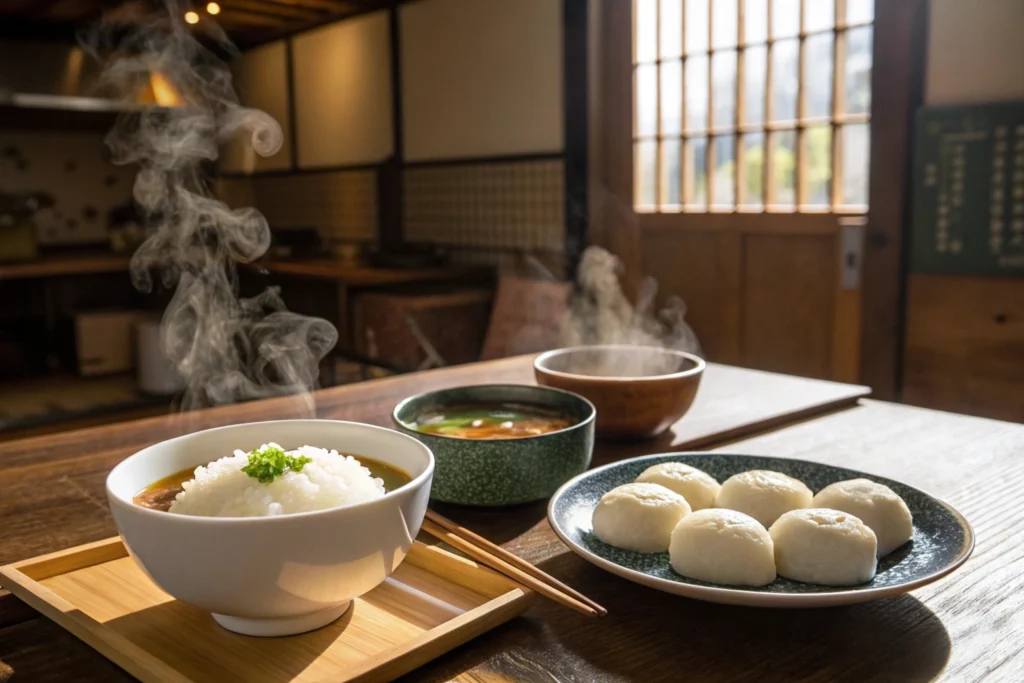
1. What is “Hot White Japanese Food”?
When you see references to hot white Japanese food, you might wonder if it’s about color, temperature, or a specific set of dishes. In truth, it combines all three. These meals, typically served warm (or even hot), center around white-colored ingredients like rice, tofu, mochi, fishcake (kamaboko), or white noodles that offer a soothing visual and gustatory experience.
Defining the Term
- White Hue: Stemming from ingredients like short-grain rice, wheat noodles, or even white-fleshed fish, these dishes often showcase a neutral palette.
- Temperature & Comfort: Typically served hot, they evoke homestyle coziness, especially in colder seasons.
- Simplicity: Many such dishes rely on minimal seasoning—like salt, soy sauce, or dashi—allowing the ingredient’s natural flavor to shine.
Long-Tail Keywords
- one food japan is known for
- typical dishes in japan
- traditional food in japan
- japanese cuisine names
- japanese foods
These keywords illustrate the broad curiosity around Japanese dishes, from iconic items to lesser-known gems.
Key Ingredients
- Rice (Gohan): Arguably Japan’s most revered staple. The short-grain variety becomes sticky and slightly sweet when cooked, ideal for forming onigiri or accompanying soups.
- Tofu: Soft or silken tofu often appears in soups or hot pots (like yudofu), boasting a subtle creaminess.
- Mochi (Pounded Rice Cakes): Chewy when grilled or boiled, mochi serves as a snack or part of soups (like ozoni during New Year celebrations).
- Fishcake (Kamaboko): A processed seafood product, often white or pink, used in soups and stir-fries, adding delicate flavor and bouncy texture.
Why the Fascination?
In Japanese culture, white foods often convey cleanliness and refined simplicity. The color white can also symbolize purity, underscoring how these meals aim to comfort without overwhelming. The contrast of a plain white canvas (like tofu or rice) with bright garnishes—scallions, nori strips, or pickles—produces a visually pleasing presentation.
Health Aspects
- Carbohydrates & Protein: Rice and noodles deliver quick energy, while tofu supplies lean protein.
- Low-Fat Cooking: Many hot white foods rely on steaming or boiling, making them lighter meal choices.
- Gentle on the Stomach: Simple seasonings, mild flavors, and easily digestible textures suit those seeking a less spicy, more soothing cuisine.
For a side dish or a main course that complements your hot white meal, explore our japanese-vegan-recipes featuring mild flavors and plant-based innovations. These can accompany or enhance a range of hot white Japanese foods, bridging taste and nourishment effortlessly.
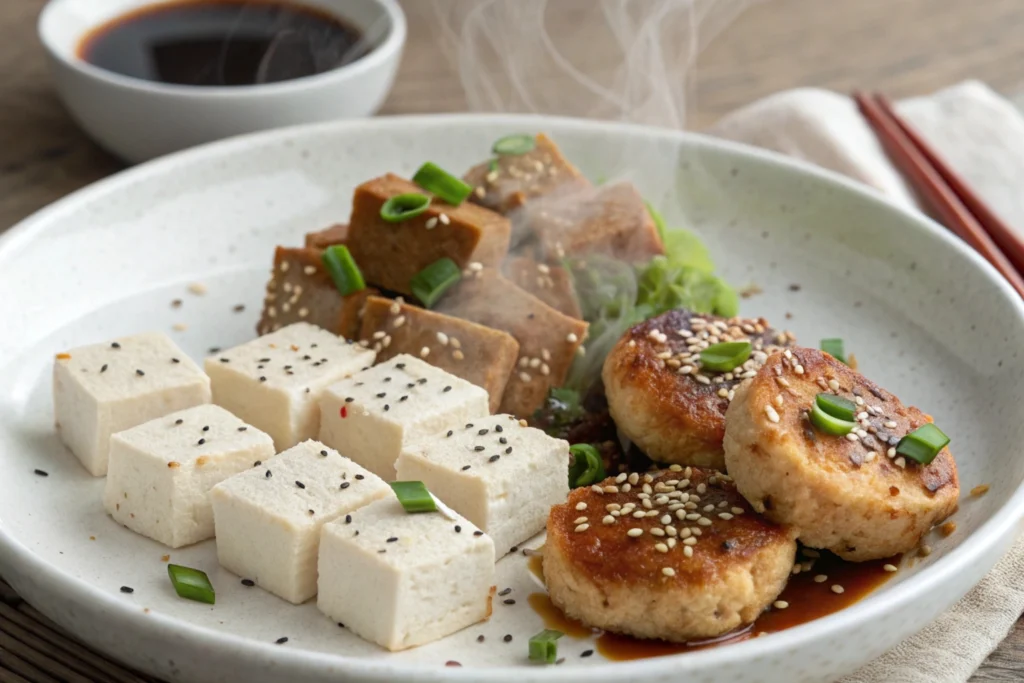
2. Steaming Rice Dishes: The Cornerstone of Japanese Cuisine
No discussion of hot white Japanese food is complete without delving into rice. Warm, fluffy, and central to countless meals, rice is one food Japan is known for. Beyond its staple status, rice fosters a sense of continuity and heritage, symbolizing nourishment and cultural identity.
Varieties of Japanese Rice
- Short-Grain Japonica: The primary type used in everyday cooking. It’s sticky and slightly sweet, forming the basis of sushi, onigiri, and plain bowls of gohan (cooked rice).
- Medium-Grain Calrose: Less common in Japan but popular abroad. Slightly less sticky than short-grain yet still suitable for many Japanese dishes.
Popular Hot Rice Dishes
- Plain Steamed Rice (Gohan)
- Eaten with nearly every meal.
- Typically served in small bowls, often accompanied by miso soup, pickles, and a main protein.
- Oyakodon (Chicken and Egg Bowl)
- A sweet-salty mixture of chicken, onions, and beaten eggs simmered in soy sauce, then ladled over hot rice.
- The name means “parent and child bowl,” reflecting chicken (parent) and egg (child).
- Katsudon (Pork Cutlet Bowl)
- Breaded pork cutlet (tonkatsu) simmered with onions in a lightly sweet sauce, then poured over rice with a beaten egg.
- Crisp, rich, and satisfying, balancing textures between tender pork and fluffy rice.
- Donburi Specials
- Gyudon (beef bowl), tendon (tempura bowl), and unadon (grilled eel bowl) are other top faves, all served over piping hot rice.
Mastering the Perfect Rice
- Rinsing: Wash grains until water runs nearly clear to remove excess starch.
- Water Ratio: Roughly 1:1.1 or 1:1.2 (rice to water) for short-grain; personal preference may vary.
- Resting: After cooking, letting rice sit for 10-15 minutes helps it fully absorb moisture.
Health & Nutrition
Steamed rice offers a steady carb source. Paired with miso soup and pickles, a balanced meal emerges. In many households, the simple act of having fresh, hot rice daily anchors nutritional well-being and fosters a mindful eating routine.
Rice in Cultural Context
From festivals (like the harvest celebration of Niiname-sai) to everyday lunches, rice remains integral. Many japanese cuisine names revolve around it—like chirashizushi or takikomi gohan. Even mochi, a popular white treat, stems from pounded glutinous rice.
Try your hand at a savory rice dish with our japanese-chicken-fried-rice-recipe-2. Though fried rice is distinct from a classic steamed bowl, it captures the same spirit of comfort and adaptability.
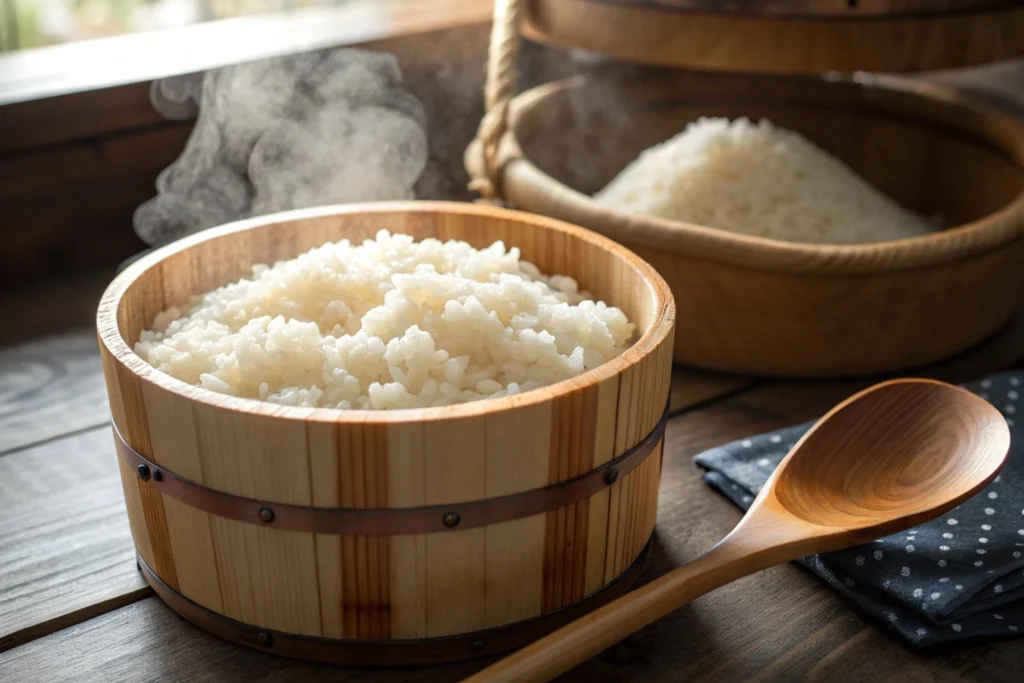
3. White Soups and Broths
If you’ve ever sipped a creamy soup or a white stew in Japan, you’ve encountered another domain of hot white Japanese food. While miso soup is commonly brownish, some soup variations lean distinctly white—blending soy milk, miso, or other pale ingredients to create a gentle, warming bowl.
Soy Milk Soup (Tonyu Nabe)
- Concept: Tonyu means “soy milk,” and nabe refers to a communal hot pot dish. Combining vegetables, tofu, mushrooms, and a mild broth yields a creamy, low-fat soup.
- Preparation: A base dashi is mixed with unsweetened soy milk, delivering a subtly nutty taste. Miso or salt can adjust flavor.
- Health Perks: High in plant-based protein, often well-tolerated by those avoiding dairy.
Shio Koji Broth
- What is Koji: A fermented mold used to bring out umami, known for adding gentle sweetness and softness to soups.
- Koji in White Soups: Koji-based broth can appear whiteish due to suspended yeast or starches. Pairing it with vegetables or proteins gives a mild tang and deeper complexity.
White Fish Broth
- Fish Dashi: Combining fish bones with kombu can result in a cloudy, milky soup if simmered carefully, often employed in certain regional dishes.
- Example: Hokkaido’s fish soup might feature white-fleshed cod or pollock, forming a thick, comforting meal in cold climates.
White Curry and Cream Stew
- Japanese Cream Stew: Resembling Western stew but with a Japanese twist—milk or cream thickened with roux. Carrots, potatoes, onions, and chicken usually star.
- White Curry: Less common than standard yellow curry, but some regions experiment with adding cream or coconut milk to lighten hue, creating a unique mild spice.
Toppings and Sides
- Green Garnishes: Chopped scallions or mitsuba (Japanese parsley) provide color contrast.
- Croutons or Rice: Some Western-influenced Japanese stews incorporate small bread cubes, though many prefer a side of warm, sticky rice.
Dining Tradition
Hot soups are especially popular in winter, fulfilling the desire for a comforting, belly-warming experience. Households often unify around a communal pot—like tonyu nabe—where family members select their ingredients, fostering closeness.
If you’d like to try a white-based soup yourself, look to vegetables-japanese-recipe for ideas on pairing fresh produce with mild, creamy broths. The results can be both visually appealing and soothing to taste.
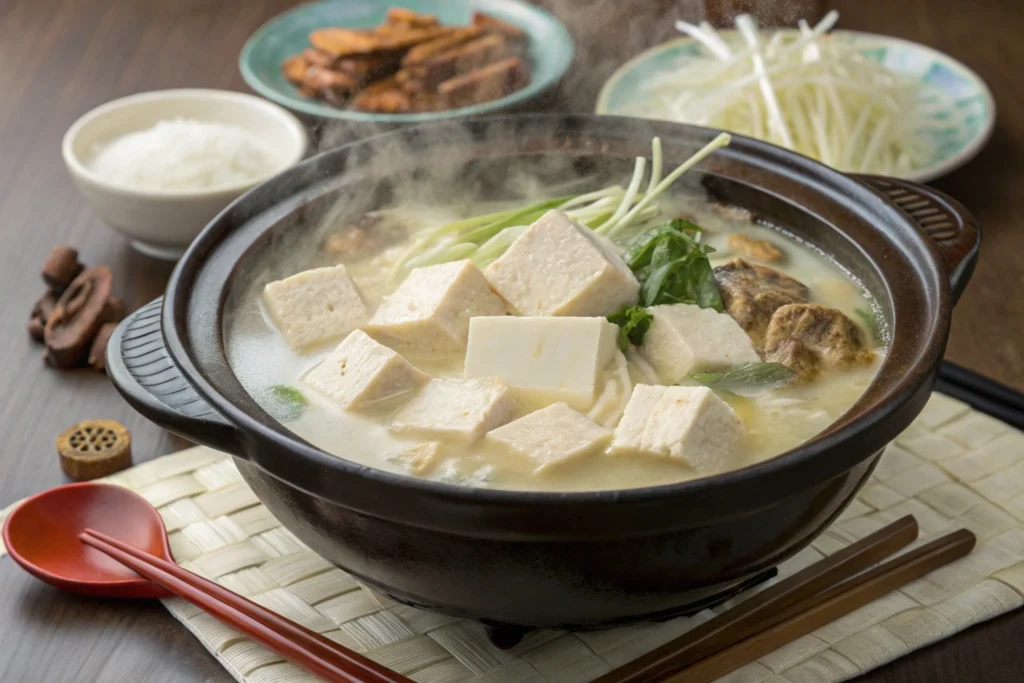
4. Mochi and Sticky Delights
Mochi, a white sticky Japanese food, encapsulates the chewy, soft hallmark of hot white Japanese food. Though mochi is often associated with sweets or desserts, it also plays a big role in savory contexts—like ozoni soup—particularly during New Year’s celebrations.
Mochi Basics
- Production: Glutinous rice (mochigome) is soaked, steamed, then pounded vigorously until smooth and elastic.
- Types of Mochi:
- Fresh Mochi: Soft, pliable lumps shaped right after pounding.
- Dried Mochi (Kiri Mochi): Firm blocks that keep longer; can be toasted or cooked in soup.
- Flavor & Texture: Mild in taste, mochi’s appeal lies in its gooey chew and ability to absorb surrounding flavors.
Hot Mochi Dishes
- Ozoni: A traditional New Year’s soup containing grilled or boiled mochi alongside vegetables and protein in a clear or miso-based broth.
- Isobeyaki: Toasted mochi wrapped in nori, drizzled with soy sauce, and sometimes sweet sauce—a savory snack with crisp exterior.
- Kinako Mochi: Although often served at room temperature, it can be lightly warmed, then coated in kinako (soybean powder) and sugar.
Beyond Mochi: Sticky Rice Variants
- Okowa or Sekihan: Glutinous rice dishes mixed with beans or chestnuts, sometimes appearing pinkish or other pale hues when cooked with certain legumes.
- Onigiri: While classic onigiri uses standard short-grain rice, some incorporate mochi rice blends for extra stickiness, especially in certain regional recipes.
Safety & Enjoyment
Chewing mochi thoroughly is crucial because of its sticky, elastic nature. Elderly folks or children sometimes prefer smaller pieces or extra chewing time to avoid choking hazards.
Serving Suggestions
- Sweet Toppings: Anko (red bean paste) or a drizzle of sweet soy sauce for dessert-like mochi.
- Savory Pairings: Combine with soy sauce, mirin, and chili flakes for a subtle spicy glaze, or pop mochi chunks into miso soup for a textural twist.
Explore how mochi can enhance soups and stir-fries by referencing our minced-beef-japanese-recipe and adding mochi slices as a playful garnish. The starchiness of mochi can provide a unique complement to savory dishes.

5. White Noodles and Dumplings
When it comes to hot white Japanese food, white noodles and dumplings also claim the spotlight. From silky udon bowls to plump gyoza wrappers, these items provide a comforting mouthfeel and—when served hot—aptly fit this cozy culinary category.
Udon: Thick and Chewy
- Appearance: Thick, white wheat noodles known for their springy texture.
- Serving Styles:
- Kake Udon: Plain udon in a mild dashi broth.
- Kitsune Udon: Topped with fried tofu (aburaage).
- Tempura Udon: Garnished with crispy prawn or vegetable tempura.
- Temperature: Udon can be served hot or cold, but hot variations are especially appealing for chilly seasons.
Shirataki Noodles
- Definition: Translucent, gelatinous noodles made from konjac yam, nearly zero calories.
- Uses: Often in sukiyaki or hot pot (nabe), adopting the color of other ingredients in the broth.
- Texture: Slightly firm, somewhat slippery, beloved by those seeking low-carb alternatives.
White Dumplings
- Gyoza Wrappers: Although gyoza (Japanese pot stickers) often appear lightly browned after pan-frying, their wrappers start off a soft white. Steamed versions maintain this pale hue.
- Shiro Dango: Sweet or savory dumplings formed from rice flour, frequently skewered as dango and simmered or grilled, served with sweet soy glaze.
Soup Pairings
Slipping these noodles or dumplings into hot broths intensifies their warmth and comfort. For instance, chicken-based soup with udon, or shabu-shabu hot pot finishing with shirataki, capture Japan’s communal dining essence.
Regional Variations
- Sanuki Udon (Kagawa): Known for extra firmness.
- Iwate Prefecture: Special dumplings like hittsumi, dough lumps simmered in soup, offering a white, doughy experience.
For a heartier meal, top white noodles with slices of roast meat or a drizzle of fermented sauce. You can find sauce inspiration from our japanese-barbecue-sauce-recipes to discover how sweet and tangy flavors amplify the gentle nature of these noodles.
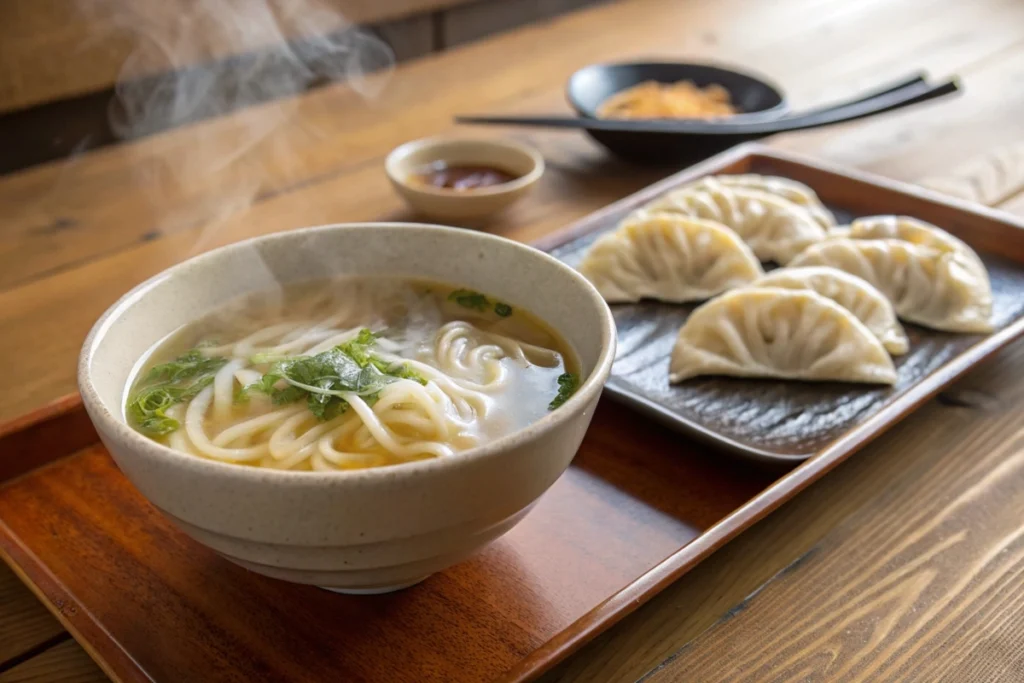
History/Context
Hot white Japanese food emerges from centuries of evolving food culture, rooted in both necessity and tradition. White, steamy dishes often trace their lineage to rice agriculture, Buddhist influences, and resourceful cooking methods adapted from earlier eras.
Ancient Beginnings
Japan’s terrain and climate favored short-grain rice cultivation. Over time, rice became a spiritual and social cornerstone—offered in shrines, consumed at celebrations, and forming the daily meal’s nucleus. Simultaneously, proximity to water spurred the development of mild, watery dishes that highlight local fish and produce.
Influence of Buddhism
Around the 6th century, Buddhism’s arrival introduced vegetarian norms in temples. Monks refined techniques using tofu, wheat-based noodles, and simpler seasonings. White dishes like tofu or mochi served in hot broths mirrored the monks’ pursuit of purity and minimalism. This aesthetic, emphasizing modest flavors, contributed to the concept that white signified sanctity and plainness.
Rise of Staple Grains and Starches
As trade expanded domestically and internationally, new ideas about preparing rice and wheat flour circulated. White noodles (udon) thrived in some regions, while mochi’s role grew in festivities. The color white implied something “refined,” pushing households to produce whiter rice or flours for higher status or ceremonial events.
Regional Transformations
In mountainous or colder areas, hot white foods addressed practicality: thick stews, dumplings, and mochi-based soups provided hearty sustenance in harsh winters. Coastal communities integrated fresh seafood into milky broths, bridging land and sea flavors. Over centuries, these local variations enriched the national tapestry.
Modern-Day Significance
Despite modern global influences—ranging from Western fast-food to instant ramen—traditional hot white dishes persist as comfort foods. They appear at seasonal gatherings, from New Year’s ozoni to the daily onigiri lunch. White foods, often mild, easily accommodate cross-cultural fusions, allowing chefs to adapt them while preserving their subtle essence.
Symbolism and Ritual
From weddings (where pure white mochi might symbolize good fortune) to funerals (where plain rice sometimes conveys respect), color and temperature intersect with deeper meaning. White stands for both beginnings and endings, linking life’s cyclical nature to the warmth of these dishes.
Overall, hot white Japanese food is not just about color or temperature. It encapsulates centuries of agricultural adaptation, religious influence, and regional ingenuity, forming an enduring culinary tradition that resonates today. For more context on classic Japanese staples, visit our japanese-old-fashioned-recipe to see how even drinks integrate historical techniques and flavors.

Practical Examples/Use Cases
1. A Cozy Winter Dinner for the Family
On a chilly evening, Miho prepares a meal centered on hot white Japanese food. Steamed white rice forms the base, accompanied by a pot of soy milk nabe (tonyu nabe) brimming with tofu, napa cabbage, and mushrooms. She grills mochi squares as a side snack—lightly crisp outside, chewy within—and sprinkles them with soy sauce. The result? A hearty spread that warms her family and celebrates Japan’s comfort cuisine.
2. Street Food Stall Serving White-On-White Delights
In Osaka, a street food vendor experiments with creative spins on white dishes. He offers cups of hot udon noodles topped with grated daikon radish (white on white) and a drizzle of chili oil. There’s also a mochi skewer station where passersby watch squares puff over a tiny grill. The stall quickly becomes a popular Instagram spot, highlighting the visual appeal of pale-hued comfort food.
3. Health-Conscious Lunch
Keiko, aiming to watch her calorie intake, opts for a bowl of plain steamed rice and a clear soup with white fish slices. She tops the soup with tofu cubes and wakame for added flavor and nutrients. This meal underscores the ease of combining typical white staples—rice and tofu—to achieve a light, balanced approach to lunch without sacrificing taste.
4. Holiday Potluck
During a holiday potluck in Tokyo, friends bring dishes that fit the “hot white” theme. One arrives with a casserole of creamy white stew loaded with winter vegetables, while another crafts mochi dumplings in a mushroom-based soup. Each dish stands out for its purity of color and soothing qualities, reflecting how traditional food in japan merges seamlessly into modern gatherings.
From cozy family dinners to potlucks and city stalls, hot white foods flourish across Japan’s culinary landscapes. For those who prefer meaty accompaniments to these soft dishes, try pairing them with steak-japanese-recipe for a satisfying fusion that balances robust flavors with mild bases.
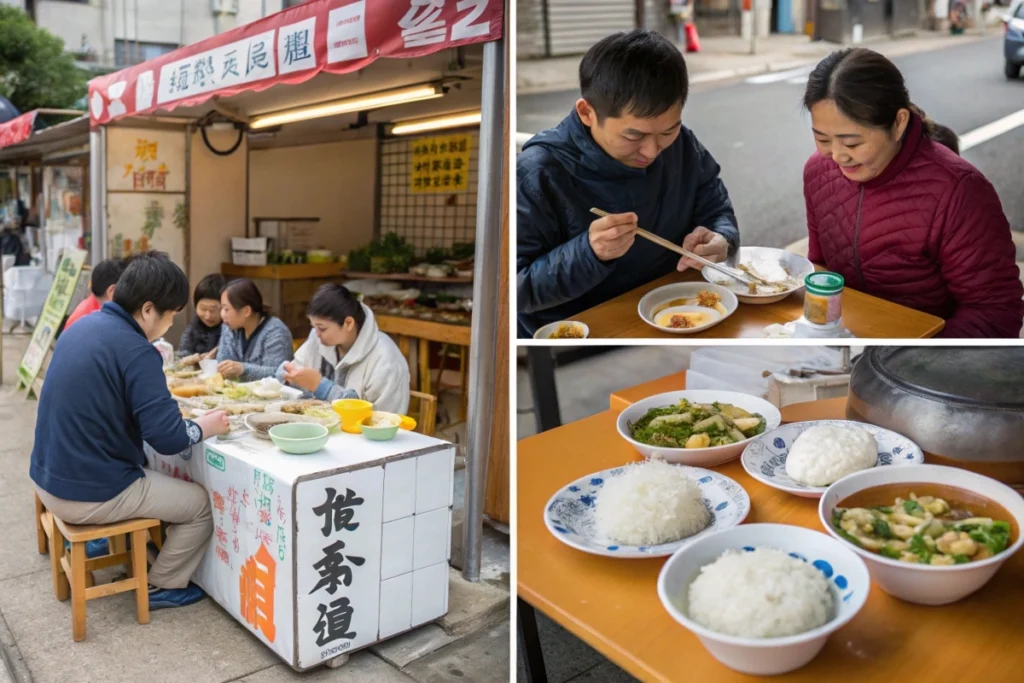
FAQs
Q1: What is a hot dish in Japanese?
A “hot dish” in Japanese could be anything served warm, but a typical example is nabemono (hot pot). For hot white Japanese food, think soy milk nabe (tonyu nabe) with tofu or mochi-based soups.
Q2: What is the white sticky Japanese food?
It’s likely mochi, made from pounded glutinous rice (mochigome). Once steamed and pounded, mochi becomes sticky and can be grilled, boiled, or put in soups. Another possibility is sticky short-grain rice, common in daily meals.
Q3: What’s the spiciest Japanese dish?
While Japanese cuisine isn’t renowned for extreme heat, dishes like tantan ramen or spicy miso-based soups can pack a punch. However, “spiciest” remains relative, especially compared to other Asian cuisines. If seeking intense spice, you may want to add chili oil or pepper pastes.
Q4: What is the white cube Japanese food?
Tofu often appears in cube form, especially silken tofu (kinugoshi) or firm tofu (momen). Another white cube could be kiri mochi, a rectangular dried mochi. Both are staples in hot soups or grilled as standalone snacks.
Q5: Can I find these dishes outside Japan?
Yes! Many Japanese restaurants worldwide feature mochi, udon, tofu soups, and white rice bowls. Additionally, Asian grocery stores often stock mochi, dried noodles, and broth bases for at-home preparation.
Q6: Are these foods vegetarian/vegan-friendly?
Many can be, especially tofu dishes, mochi, and certain white soups relying on soy milk or vegetable-based stocks. Be mindful of dashi (fish-based stock) if aiming for complete vegetarian/vegan recipes. Our japanese-vegan-recipes are perfect for exploring plant-based variations.
Q7: How do I incorporate these foods into daily meals without it becoming repetitive?
Rotate your base—alternate between plain rice, udon, and tofu soups. Experiment with toppings and side dishes. A mochi snack or dumpling can add variety. Little seasoning tweaks (like miso, soy sauce, or chili oil) ensure each meal feels distinct.
Conclusion
Hot white Japanese food offers warmth, solace, and a visual serenity that resonates with Japan’s minimalist culinary spirit. From steamed rice that forms the cornerstone of daily meals to mochi lumps bobbing in a New Year’s soup, these pale-hued dishes embody comfort and tradition. They’re versatile enough for quick lunches, festive potlucks, or refined restaurant fare, reflecting Japan’s unwavering dedication to quality and delicate flavor.
Through exploring everything from mochi and tofu to silky udon and gentle white soups, we see how color, temperature, and simplicity converge into a delicious subset of Japanese cuisine. Whether you’re learning to steam rice to perfect fluffiness or seeking the best tofu for soy milk nabe, these dishes encourage a mindful approach to cooking and eating. Pair them with bold sauces, bright pickles, or robust proteins for a balanced meal—like referencing our authentic-japanese-barbecue-sauce-chicken-recipe-easy-delicious for a flavor-forward contrast.
In the end, hot white Japanese food isn’t about monotony; it’s about appreciating the subtle art of warmth and color, whether served during a quiet family dinner or showcased at a bustling eatery. Give these mild, comforting bites a try, and let Japan’s gentle culinary elegance draw you into a world of understated, delicious beauty.
